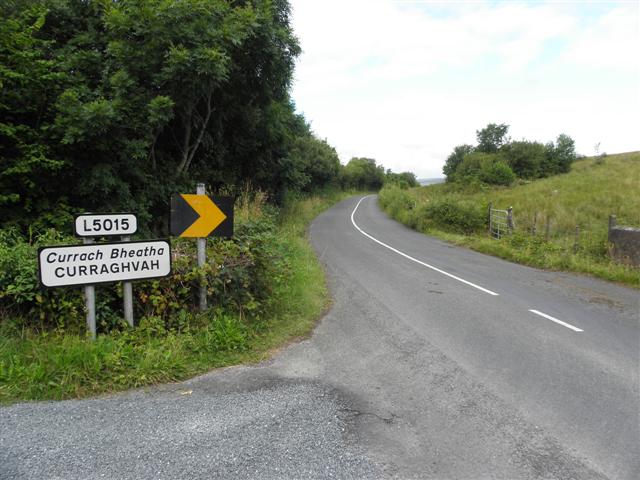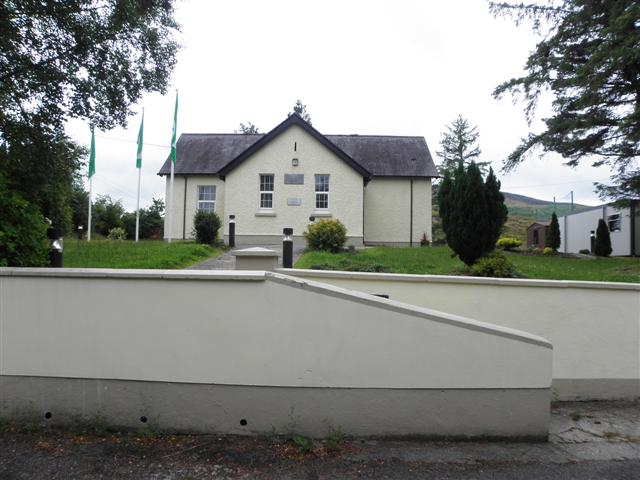Curraghvah National School Geograph-3586642-by-Kenneth--Allen on:
[Wikipedia]
[Google]
[Amazon]
Curraghvah, an Anglicisation of the Gaelic, either ‘Currach Bheathach’, meaning ''The Moor of the Birches'', or ‘Currach a’ Mhagh’, meaning ''The Moor of the Plain'', or ‘Currach Mheádh’ meaning ''The Moor of the Spicy Mead Drink'', is a townland in the civil parish of Templeport, 
 # A medieval earthen ringfort. The 'Archaeological Inventory of County Cavan' (Site no. 493) describes it as- ''Raised circular area (int. dims. 26.2 NE-SW; 23.3m NW-SE) enclosed by two earthen banks with a wide, deep, waterlogged intermediate fosse. Although the NW half of the site has been largely levelled, the outline of the perimeter is still identifiable. Original entrance not recognisable. Short stretch of relatively recent drystone walling on internal face of inner bank at E. A small stone-lined subcircular depression at the centre of the interior is believed to be a spring well (OPW 1977). Situated on the floor of an upland valley''.
# Curraghvah National School. In 1933 the school was opened with the intention of replacing a 19th century school in
# A medieval earthen ringfort. The 'Archaeological Inventory of County Cavan' (Site no. 493) describes it as- ''Raised circular area (int. dims. 26.2 NE-SW; 23.3m NW-SE) enclosed by two earthen banks with a wide, deep, waterlogged intermediate fosse. Although the NW half of the site has been largely levelled, the outline of the perimeter is still identifiable. Original entrance not recognisable. Short stretch of relatively recent drystone walling on internal face of inner bank at E. A small stone-lined subcircular depression at the centre of the interior is believed to be a spring well (OPW 1977). Situated on the floor of an upland valley''.
# Curraghvah National School. In 1933 the school was opened with the intention of replacing a 19th century school in
The IreAtlas Townland Data Base
{{County Cavan Townlands of County Cavan Lime kilns in Ireland
County Cavan
County Cavan ( ; gle, Contae an Chabháin) is a Counties of Ireland, county in Republic of Ireland, Ireland. It is in the Provinces of Ireland, province of Ulster and is part of the Border Region. It is named after the town of Cavan and is base ...
, Ireland. It lies in the Roman Catholic parish of Glangevlin
Glangevlin () is a village in the northwest of County Cavan, Ireland. It is in the townlands of Gub (Glangevlin) and Tullytiernan, at the junction of the R200 and R207 regional roads. It is surrounded by the Cuilcagh Mountains and borders the c ...
and barony of Tullyhaw. 
Geography
Curraghvah is bounded on the north by Creea and Drumhurrin townlands, on the west by Coppanaghbane and Gowlat townlands, on the east by Legnagrow,Moneenabrone
Moneenabrone, an Anglicisation of the Gaelic, ‘Moínín na Brón’, meaning ''The Little Bog of the Quern-stone'', is a townland in the civil parish of Templeport, County Cavan, Ireland. It lies in the Roman Catholic parish of Glangevlin and ...
and Mully Lower
Mully Lower, an Anglicisation of the Gaelic, ‘Mullach Íochtar’ meaning ''The Lower Summit of the Hill'', is a townland in the civil parish of Templeport, County Cavan, Ireland. It lies in the Roman Catholic parish of Glangevlin and barony o ...
townlands and on the south by Coppanaghmore townland. Its chief geographical features are the Owenmore River (County Cavan)
The Owenmore River ( ga, Abhainn Mór, meaning "Big River") rises in the Cuilcagh Mountains, in the townland of Dunmakeever, civil parish of Kinawley, Roman Catholic parish of Glangevlin, Barony of Tullyhaw, County Cavan. It then flows in a nort ...
, mountain streams, waterfalls, a wood, gravel pits, a dug well and spring wells. The townland is traversed by the regional R200 road (Ireland), minor public roads and rural lanes. The townland covers 398 statute acres.
History
In earlier times the townland was probably uninhabited as it consists mainly of bog and poor clay soils. It was not seized by the English during the Plantation of Ulster in 1610 or in the Cromwellian Settlement of the 1660s so some dispossessed Irish families moved there and began to clear and farm the land. By 1720 Morley Saunders, was the owner of the townland. By deed dated 28 July 1720 the aforesaid Morley Saunders leased the townland of ''Carravae'', whose tenant was Brian Dolan, to Richard Hassard for a term of 31 years. A deed dated 13 November 1738 includes: ''Carrova''. The 1790 Cavan Carvaghs list spells the name as ''Corvagh''. The Tithe Applotment Books for 1826 list seven tithepayers in the townland. The Ordnance Survey Name Books for 1836 give the following description of the townland- ''The soil is of a light gravelly nature and yields middling crops...There is an ancient fort near the north side and several middling good stone houses but there is nothing remarkable whatever''. The Curraghvah Valuation Office Field books are available for July 1839.Griffith's Valuation
Griffith's Valuation was a boundary and land valuation survey of Ireland completed in 1868.
Griffith's background
Richard John Griffith started to value land in Scotland, where he spent two years in 1806-1807 valuing terrain through the examinati ...
of 1857 lists thirty-four landholders in the townland.
In the 19th century, the landlord of Curraghvah was the Annesley Estate.
Census
In the 1901 census of Ireland, there are twenty-one families listed in the townland. In the1911 census of Ireland
The 1911 Census of Ireland was the last census that covered the whole island of Ireland. Censuses were taken at ten-year intervals from 1821 onwards, but the 1921 census was cancelled due to the Irish War of Independence.
The original records o ...
, there are twenty-two families listed in the townland.
Antiquities
 # A medieval earthen ringfort. The 'Archaeological Inventory of County Cavan' (Site no. 493) describes it as- ''Raised circular area (int. dims. 26.2 NE-SW; 23.3m NW-SE) enclosed by two earthen banks with a wide, deep, waterlogged intermediate fosse. Although the NW half of the site has been largely levelled, the outline of the perimeter is still identifiable. Original entrance not recognisable. Short stretch of relatively recent drystone walling on internal face of inner bank at E. A small stone-lined subcircular depression at the centre of the interior is believed to be a spring well (OPW 1977). Situated on the floor of an upland valley''.
# Curraghvah National School. In 1933 the school was opened with the intention of replacing a 19th century school in
# A medieval earthen ringfort. The 'Archaeological Inventory of County Cavan' (Site no. 493) describes it as- ''Raised circular area (int. dims. 26.2 NE-SW; 23.3m NW-SE) enclosed by two earthen banks with a wide, deep, waterlogged intermediate fosse. Although the NW half of the site has been largely levelled, the outline of the perimeter is still identifiable. Original entrance not recognisable. Short stretch of relatively recent drystone walling on internal face of inner bank at E. A small stone-lined subcircular depression at the centre of the interior is believed to be a spring well (OPW 1977). Situated on the floor of an upland valley''.
# Curraghvah National School. In 1933 the school was opened with the intention of replacing a 19th century school in Carrick West
Carrick West, (), is a townland in the civil parish of Templeport, County Cavan, Ireland. It is named Carrick West or Carrick Hassard to distinguish it from Carrick East or Carrick Fisher townland which is in Templeport parish. It lies in the Ro ...
townland, which was closed. In 1938 the pupils of the school recorded local folklore. In 1979 Tullycasson school was amalgamated with Curravagh N.S., leaving Curravagh as the sole remaining school in the area.
# A stone bridge over the river.
# A lime-kiln
# Stepping stones over the river
# A foot-stick over the river.
References
External links
The IreAtlas Townland Data Base
{{County Cavan Townlands of County Cavan Lime kilns in Ireland